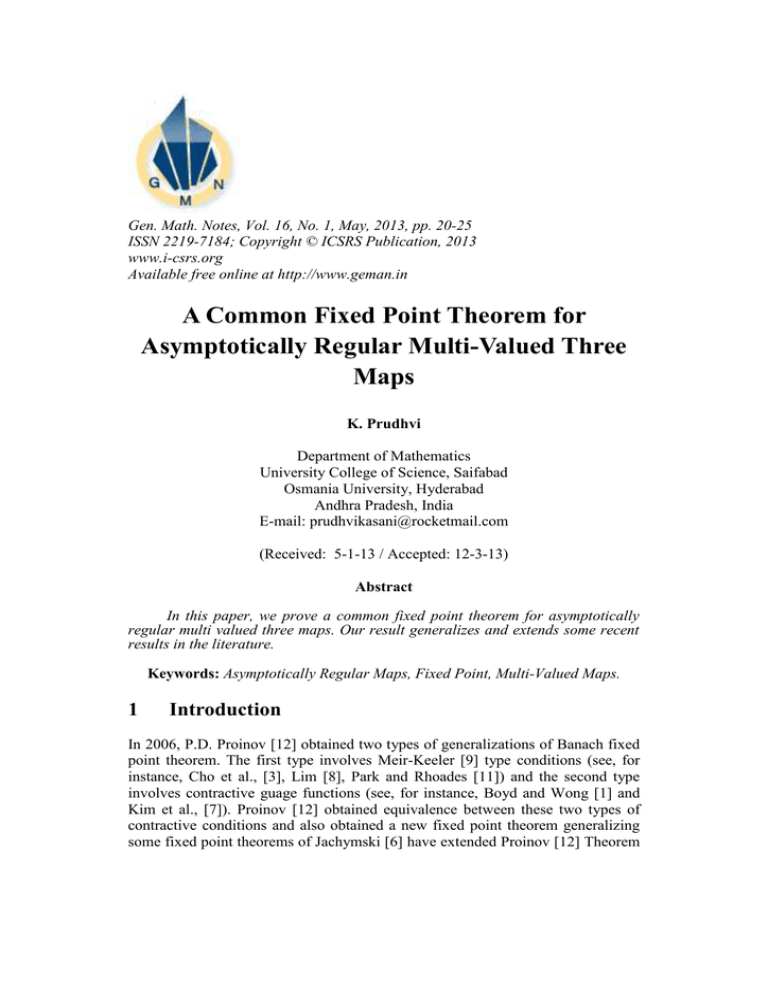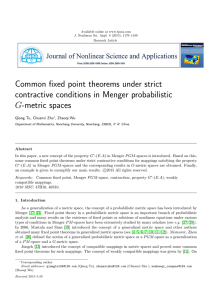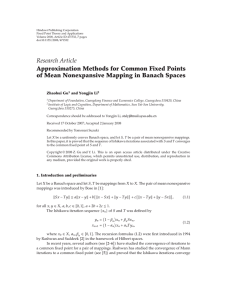Gen. Math. Notes, Vol. 16, No. 1, May, 2013, pp.... ISSN 2219-7184; Copyright © ICSRS Publication, 2013
advertisement

Gen. Math. Notes, Vol. 16, No. 1, May, 2013, pp. 20-25
ISSN 2219-7184; Copyright © ICSRS Publication, 2013
www.i-csrs.org
Available free online at http://www.geman.in
A Common Fixed Point Theorem for
Asymptotically Regular Multi-Valued Three
Maps
K. Prudhvi
Department of Mathematics
University College of Science, Saifabad
Osmania University, Hyderabad
Andhra Pradesh, India
E-mail: prudhvikasani@rocketmail.com
(Received: 5-1-13 / Accepted: 12-3-13)
Abstract
In this paper, we prove a common fixed point theorem for asymptotically
regular multi valued three maps. Our result generalizes and extends some recent
results in the literature.
Keywords: Asymptotically Regular Maps, Fixed Point, Multi-Valued Maps.
1
Introduction
In 2006, P.D. Proinov [12] obtained two types of generalizations of Banach fixed
point theorem. The first type involves Meir-Keeler [9] type conditions (see, for
instance, Cho et al., [3], Lim [8], Park and Rhoades [11]) and the second type
involves contractive guage functions (see, for instance, Boyd and Wong [1] and
Kim et al., [7]). Proinov [12] obtained equivalence between these two types of
contractive conditions and also obtained a new fixed point theorem generalizing
some fixed point theorems of Jachymski [6] have extended Proinov [12] Theorem
A Common Fixed Point Theorem for…
21
4.1 into multi valued maps. In this paper we extend Theorem 2.2 of S.L. Singh et
al. [16] for three maps.
Asymptotic regularity for single- valued map is due to Browder and Petryshyn [2].
Definition 1.1: A self-map T on a metric space (X, d) is asymptotic regular if
lim
n→∞
d(Tn x, Tn+1x) = 0 for each x ∈ X .
Rohades et al., [14] and Singh et al., [17] have extended this concept of
asymptotic regularity to multi-valued maps as follows.
Definition 1.2: Let (X, d) be a metric space and S: Y→CL(X). S is asymptotically
regular at xo ∈ X if for any sequence {xn} in Y and each sequence {yn} in Y such
that
yn ∈ Sxn-1
lim
( yn , yn+1 ) = 0.
n→∞
Definition 1.3: Let (X, d) be a metric space and S, T: Y→CL(X). A pair (S,T) is
said to be asymptotically regular at xo ∈ X , if for any sequence {xn} in X and each
lim
sequence {yn} in X such that yn ∈ Sxn-1 ∪ Txn-1,
d( yn , yn+1 ) = 0 .
n→∞
Definition 1.4: Let f: Y→Y and S:Y→2Y the collection of non-empty sub set of Y.
Then the hybrid pair (S, f) are (IT)-Commuting on Y if fSz ⊆ Sfz for all z ∈ Y.
2
Common Fixed Point Theorem
The following theorem is extension and improves the Theorem of S.L. Singh et al.,
[16].
Theorem 2.1: Let (X, d) be a metric space and f: Y→X and S, T: Y→CL(X) such
that
(C1). SY ∪ TY ⊆ fY.
(C2). H(Sx, Ty)≤φ(h(x,y)) for all x, y∈ Y,
where , h(x,y) = d(fx,fy)+γ[d(Sx,fx)+d(Ty,fy)], 0≤γ≤1 and φ∈Φ is continuous.
If the pair (S, T) is asymptotically regular at xo ∈ X and either S(Y) or T(Y) or f(Y)
is a complete sub space of X. Then
(i).
(ii).
C(S, f) and
C(T, f) are non-empty. Further,
22
(iii).
(iv).
(v).
K. Prudhvi
S and f have a common fixed point provided SSu=Su and S and f are (IT)Commuting at a point u ∈ C(S, f).
T and f have a common fixed point provided TTv=Tv and T and f are (IT)Commuting at a point v ∈ C(T, f).
S, T and f have a common fixed point provided that (iii) and (iv) both are
true.
Proof: We construct sequences {yn} and {xn} in Y in the following way.
Let y1 be an element of Sx0 . Since Tx1 is compact, we choose a point y2 ∈ Y
such that d(y1, y2 ) ≤H(Sx0 ,Tx1) . Again Tx2 is compact we choose a point y3 ∈ Y
such that
d(y2, y3 ) ≤H(Sx1 ,Tx2) continuing in the same manner we get
d(yn, yn+1 ) ≤H(Sxn-1 ,Txn) .Since SY ∪ TY ⊆ fY, we may take
yn = fxn ∈ Sxn-1 ∪ Txn-1 for n= 1,2,…….The asymptotic regularity of the pair
(S,T) at x0
lim
implies that
d( yn , yn+1 ) = 0.
n→∞
Fix ε >0. Since φ ∈ Φ there exists δ>ε such that for any t∈(0, ∞ ) ,
∈<t<δ ⇒ ϕ (t)≤ε .
(1)
Without loss of generality we may assume that δ≤2ε. By the asymptotic regularity
of the pair (S,T) at x0 ,
lim
d( yn , yn+1 ) = 0.
n→∞
So, there exists an integer N1 ≥1 such that
δ −ε
d( yn , yn+1 ) ≤ H(Sxn-1 , Txn ) <
, m≥ N1 .
1 + 2γ
By the induction we show that
δ + 2γε
, m≥ n≥N1 .
d( yn , ym ) ≤ H(Sxn-1 , Txm-1 ) <
1 + 2γ
Let n> N1 be fixed .Then equation (3) holds for m = n+1.
Assuming (3) to hold for an integer m≥n. We shall prove it for m+1.
By the triangle inequality, we get
d( yn , ym+1 ) ≤ d( yn , yn+1 ) + d( yn+1 , ym+1 ) .
(2)
(3)
A Common Fixed Point Theorem for…
23
That is,
d( yn , yn+1 ) ≤ d( yn , yn+1 ) + H(Sxn , Txm ) .
(4)
We shall show that
H(Sxn , Txm )≤ε .
(5)
If H(Sxn , Txm ) not less than or equal ε , then
ε < H(Sxn , Txm ) <φ(h(xn , xm) )≤ h(xn , xm)<δ.
h(xn , xm)= d(xn , xm)+γ[d(xn , Sxn) +d(xm , Txm)]
= d(xn , xm)+γ[d(xn , xn+1) +d(xm , xm+1)].
Using (2) and (3) in this inequality yields,
h(xn , xm)<
δ + 2γε
δ −ε
δ −ε
+γ
+γ
=δ.
1 + 2γ
1 + 2γ
1 + 2γ
h(xn , xm)< δ.
⇒ ε< h(xn , xm)≤ε , which is a contradiction .
Therefore, H(Sxn , Txm )≤ε. Hence (5).
(3) and (5) in (4) , we get
d( yn , ym+1 ) ≤ d( yn , yn+1 ) + H(Sxn , Txm )
<
δ −ε
+ ε.
1 + 2γ
=
δ − ε + ε + 2γε
δ + 2γε
=
.
1 + 2γ
1 + 2γ
d( yn , ym+1 )<
δ + 2γε
.
1 + 2γ
This proves (3). Since δ≤2ε, then (3) implies that
d( yn , ym+1 )< 2ε for all integers m and n with m≥n≥N1
Cauchy sequence .
and hence {yn} is a
Suppose f(Y) is complete subspace of X, then there exists a point u ∈ Y such that
fu=z. To show that z = fu ∈ Su,
24
K. Prudhvi
We suppose otherwise and use the condition (ii) we have
d(Su , Txn )≤ H(Su , Txn )≤ φ(h(u , xn))
= φ(d(fu, fxn))+γ[d(Su,fu)+ d(Txn , fxn )] ).
Letting n→∞, we get
d(Su, z) ≤ φ(d(z, z))+γ[d(Su, z)+ d(z , z )] )
= φ(0+γ[d(Su, z)])
= φ(γ d(Su, z))<d(Su, z) , (Since, φ(t)<t)
Which is a contradiction.
Therefore, z = fu ∈ Su.
Consequently, C (S, f) is non-empty. This proves (i).
Since SY ∪ TY ⊆ fY, there exists a point v∈Y such that z = fu = fv∈ Tv,
so by (ii)
d(fv, Tv) = d(fu, Tv) ≤ H(Su, Tv) ≤ φ(h(u , v))
= φ(d(fu, fv))+γ[d(Su,fu)+ d(Tv , fv )] )
= φ(d(z, z))+γ[d(z,z)+ d(Tv , fv )] )
d(fv, Tv) ≤ φ( d(Tv , fv ))< d(Tv , fv ), which is a contradiction.
Therefore, z = fu = fv ∈Tv.
Thus, C(T,f) is non-empty. This proves (ii).
Further, Su = SSu and The (IT)-Commutative of S and f at u∈ C (S, f) implies
that Su ∈ Sfu ⊆ fSu . So, Su is a common fixed point of S and f.
And Tv = TTv and the (IT)-Commutative of T and f at v∈ C (S, f) implies that
Tv∈Tfv ⊆ fTv . So, Tv is a common fixed point of T and f.
Since, z = fu∈Su and z = fu = fv∈Tv.
Therefore, T, S and f have a common fixed point.
Analogous argument establishes the theorem when S(Y) or T(Y) is a complete sub
space of X. This completes the proof.
A Common Fixed Point Theorem for…
25
Acknowledgements
The author is grateful to the referees for careful reading of my research article.
References
[1]
[2]
[3]
[4]
[5]
[6]
[7]
[8]
[9]
[10]
[11]
[12]
[13]
[14]
[15]
[16]
[17]
D.W. Boyd and J.S.W. Wong, On nonlinear contractions, Proc. Amer.
Math. Soc., 20(1969), 458-464.
F.E. Brower and W.V. Petryshyn, The solution by iteration of nonlinear
functional equations in banach spaces, Bull. Amer. Math. Soc., 72(1966),
571-575.
Y.J. Cho, P.P. Murthy and G. Jungck, A theorem of Meer-Keeler type
revisited, Int. J. Math. Math. Sci., 23(2000), 507-511.
Lj. B. Ćirić, Fixed points for generalized multivalued contractions, Math.
Vesnik., 9(24) (1972), 265-272.
S. Itoh and W. Takahashi, Single valued mappings, multivalued mappings
and fixed point theorems and fixed point theorems, J. Math. Anal. Appl.,
59(1977), 514-521.
J. Jachymski, Equivalent conditions and the Meir-Keeler type theorems, J.
Math. Anal. Appal., 194(1995), 293-303.
K.H. Kim, S.M. Kang and Y.J. Cho, Common fixed point of Φ-contactive
mappings, East. Asian Math. J., 15(1969), 211-222.
T.C. Lim, On characterization of Meer-Keeler contactive maps, Nonlinear
Anal., 46(2001), 113-120.
A. Meir and E. Keeler, A theorem on contraction mappings, J. Math. Anal.
Appl., 28(1969), 326-329.
S.B. Nadlar Jr., Multivalued contraction mappings, Pacific J. Math.,
30(1969), 475-488.
S. Park and B.E. Rhoades, Meer-Keeler type contactive conditions, Math.
Japon., 26(1981), 13-20.
P.D. Proinov, Fixed point theorems in metric spaces, Nonlinear Anal.,
64(2006), 546- 557.
B.E. Rhoades, A comparison of various definitions of contracting
mappings, Trans. Amer. Math. Soc., 226(1977), 257-290.
B.E. Rhoades, S.L. Singh and C. Kulshrstha, Coincidence theorems for
some multivalued mappings, Int. J. Math. Math. Sci., 7(3) (1984), 429-434.
S.L. Singh and S.N. Mishra, On general hybrid contractions, J. Aust. Math.
Soc. Ser., A 66(1999), 244-254.
S.L. Singh, S.N. Mishra and R. Pant, New fixed point theorems for
asymptotically regular multi-valued maps, Nonlinear Analysis, 71(2009),
3299-3304.
S.L. Singh, K.S. Ha and Y.J. Cho, Coincidence and fixed point of
nonlinear hybrid contractions, Int. J. Math. Sci., 12(2) (1989), 247-256.





